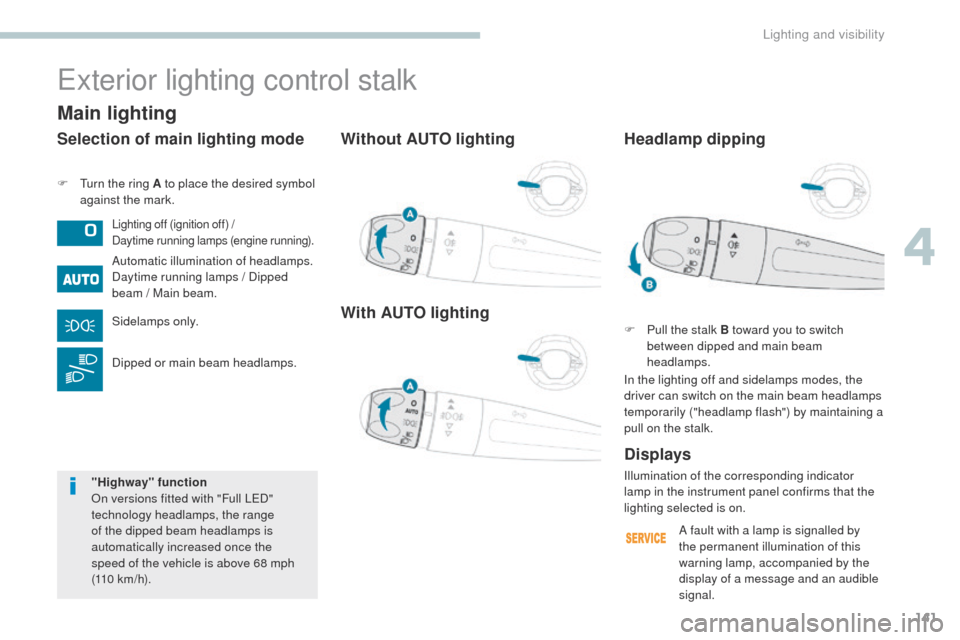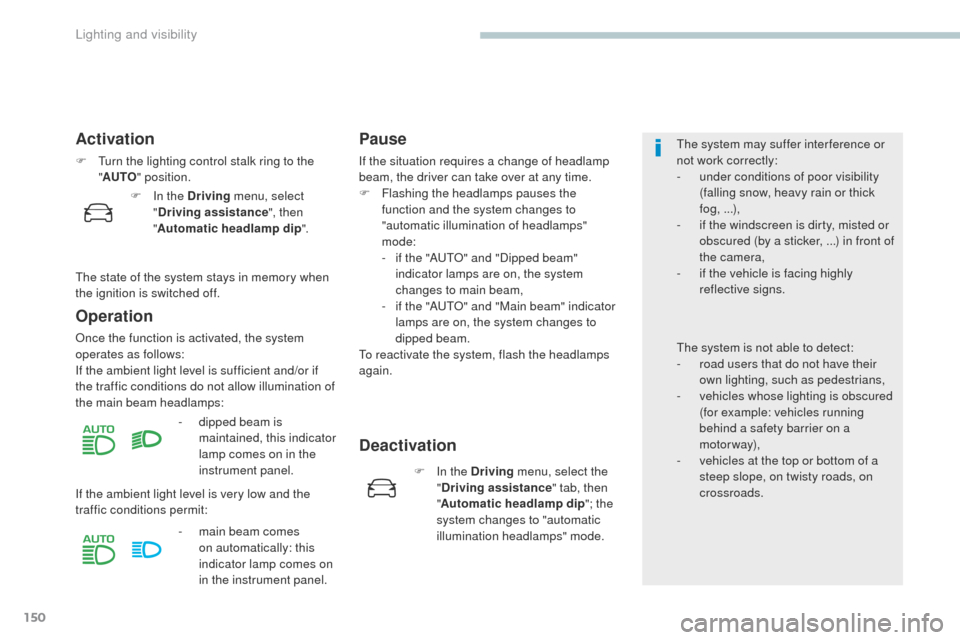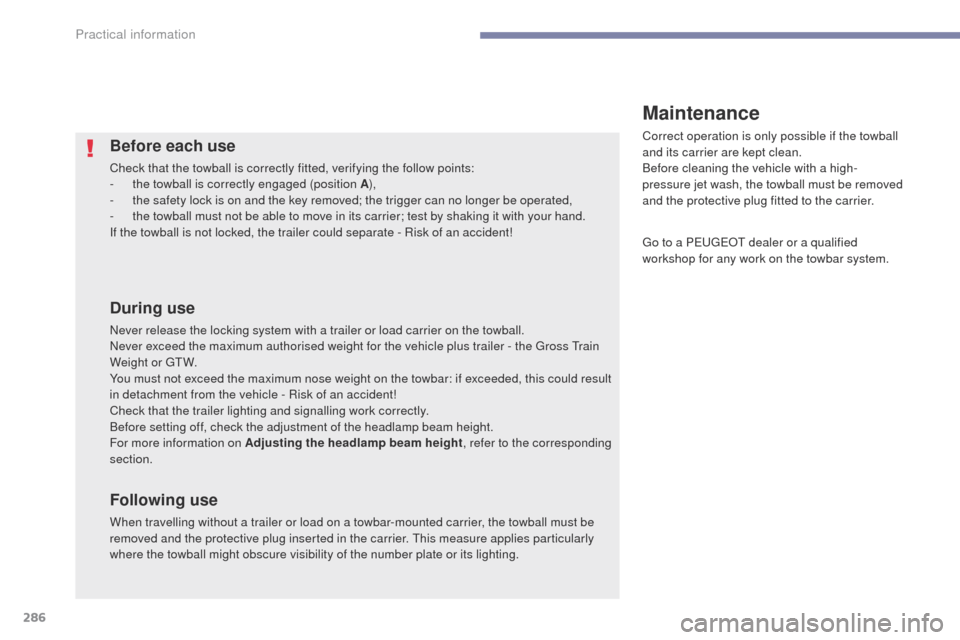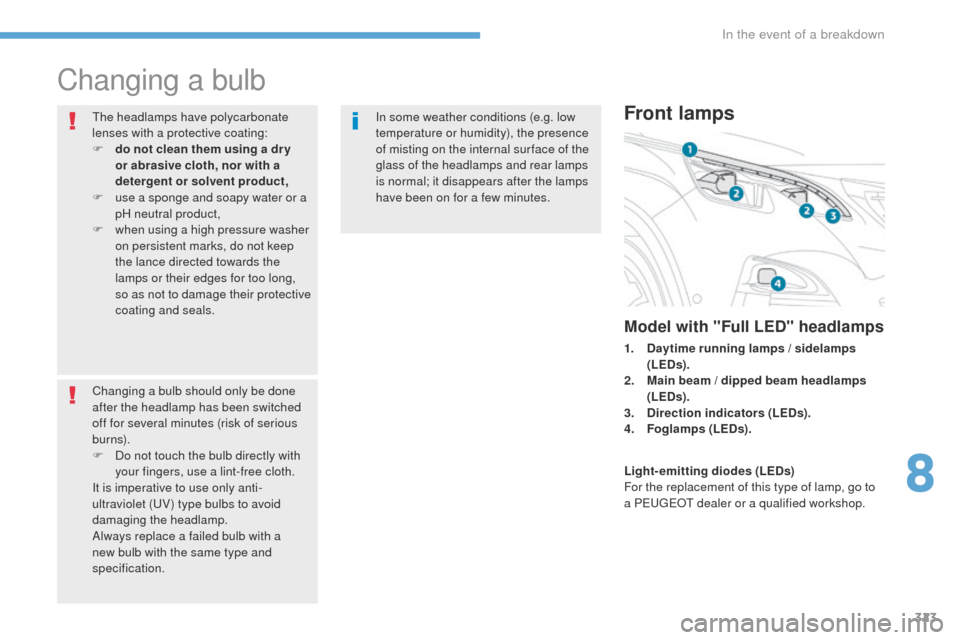Page 143 of 566

141
3008-2_en_Chap04_eclairage-et-visibilite_ed01-2016
Without AUTO lighting
With AUTO lighting
F Turn the ring A to place the desired symbol against the mark.
Exterior lighting control stalk
Lighting off (ignition off) /
Daytime running lamps (engine running).
Automatic illumination of headlamps.
Daytime running lamps / Dipped
beam / Main beam.
Sidelamps only.
Dipped or main beam headlamps.
Displays
Selection of main lighting mode
Illumination of the corresponding indicator
lamp in the instrument panel confirms that the
lighting selected is on.
Headlamp dipping
F Pull the stalk B toward you to switch
between dipped and main beam
headlamps.
In the lighting off and sidelamps modes, the
driver can switch on the main beam headlamps
temporarily ("headlamp flash") by maintaining a
pull on the stalk.
Main lighting
"Highway" function
On versions fitted with "Full LED"
technology headlamps, the range
of the dipped beam headlamps is
automatically increased once the
speed of the vehicle is above 68 mph
(110
km/h). A fault with a lamp is signalled by
the permanent illumination of this
warning lamp, accompanied by the
display of a message and an audible
signal.
4
Lighting and visibility
Page 152 of 566

150
3008-2_en_Chap04_eclairage-et-visibilite_ed01-2016
Activation
F Turn the lighting control stalk ring to the "AUTO " position.
Operation
Once the function is activated, the system
operates as follows:
If the ambient light level is sufficient and/or if
the traffic conditions do not allow illumination of
the main beam headlamps:
Pause
If the situation requires a change of headlamp
beam, the driver can take over at any time.
F
F
lashing the headlamps pauses the
function and the system changes to
"automatic illumination of headlamps"
mode:
-
i
f the "AUTO" and "Dipped beam"
indicator lamps are on, the system
changes to main beam,
-
i
f the "AUTO" and "Main beam" indicator
lamps are on, the system changes to
dipped beam.
To reactivate the system, flash the headlamps
again.
-
d
ipped beam is
maintained, this indicator
lamp comes on in the
instrument panel.
If the ambient light level is very low and the
traffic conditions permit: -
m
ain beam comes
on automatically: this
indicator lamp comes on
in the instrument panel.
Deactivation
The system may suffer interference or
not work correctly:
-
u
nder conditions of poor visibility
(falling snow, heavy rain or thick
fog, ...),
-
i
f the windscreen is dirty, misted or
obscured (by a sticker, ...) in front of
the camera,
-
i
f the vehicle is facing highly
reflective signs.
The system is not able to detect:
-
r
oad users that do not have their
own lighting, such as pedestrians,
-
v
ehicles whose lighting is obscured
(for example: vehicles running
behind a safety barrier on a
motorway),
-
v
ehicles at the top or bottom of a
steep slope, on twisty roads, on
crossroads.
F
I
n the Driving menu, select
" Driving assistance ", then
" Automatic headlamp dip ".
F
I
n the Driving menu, select the
" Driving assistance " tab, then
" Automatic headlamp dip "; the
system changes to "automatic
illumination headlamps" mode.
The state of the system stays in memory when
the ignition is switched off.
Lighting and visibility
Page 288 of 566

286
3008-2_en_Chap07_infos-pratiques_ed01-2016
Before each use
Check that the towball is correctly fitted, verifying the follow points:
- t he towball is correctly engaged (position A ),
-
t
he safety lock is on and the key removed; the trigger can no longer be operated,
-
t
he towball must not be able to move in its carrier; test by shaking it with your hand.
If the towball is not locked, the trailer could separate - Risk of an accident!
During use
Never release the locking system with a trailer or load carrier on the towball.
Never exceed the maximum authorised weight for the vehicle plus trailer - the Gross Train
Weight or GTW.
You must not exceed the maximum nose weight on the towbar: if exceeded, this could result
in detachment from the vehicle - Risk of an accident!
Check that the trailer lighting and signalling work correctly.
Before setting off, check the adjustment of the headlamp beam height.
For more information on Adjusting the headlamp beam height , refer to the corresponding
section.
Following use
When travelling without a trailer or load on a towbar-mounted carrier, the towball must be
removed and the protective plug inserted in the carrier. This measure applies particularly
where the towball might obscure visibility of the number plate or its lighting.
Maintenance
Correct operation is only possible if the towball
and its carrier are kept clean.
Before cleaning the vehicle with a high-
pressure jet wash, the towball must be removed
and the protective plug fitted to the carrier.
Go to a PEUGEOT dealer or a qualified
workshop for any work on the towbar system.
Practical information
Page 325 of 566

323
3008-2_en_Chap08_en cas-de-panne_ed01-2016
Changing a bulb
The headlamps have polycarbonate
lenses with a protective coating:
F
d
o not clean them using a dr y
or abrasive cloth, nor with a
detergent or solvent product,
F
u
se a sponge and soapy water or a
pH neutral product,
F
w
hen using a high pressure washer
on persistent marks, do not keep
the lance directed towards the
lamps or their edges for too long,
so as not to damage their protective
coating and seals.
Changing a bulb should only be done
after the headlamp has been switched
off for several minutes (risk of serious
burns).
F
D
o not touch the bulb directly with
your fingers, use a lint-free cloth.
It is imperative to use only anti-
ultraviolet (UV) type bulbs to avoid
damaging the headlamp.
Always replace a failed bulb with a
new bulb with the same type and
specification.Front lamps
Model with "Full LED" headlamps
1. Daytime running lamps / sidelamps (LEDs).
2.
M
ain beam / dipped beam headlamps
(LEDs).
3.
D
irection indicators (LEDs).
4.
Fo
glamps (LEDs).
In some weather conditions (e.g. low
temperature or humidity), the presence
of misting on the internal sur face of the
glass of the headlamps and rear lamps
is normal; it disappears after the lamps
have been on for a few minutes.
Light-emitting diodes (LEDs)
For the replacement of this type of lamp, go to
a PEUGEOT dealer or a qualified workshop.
8
In the event of a breakdown